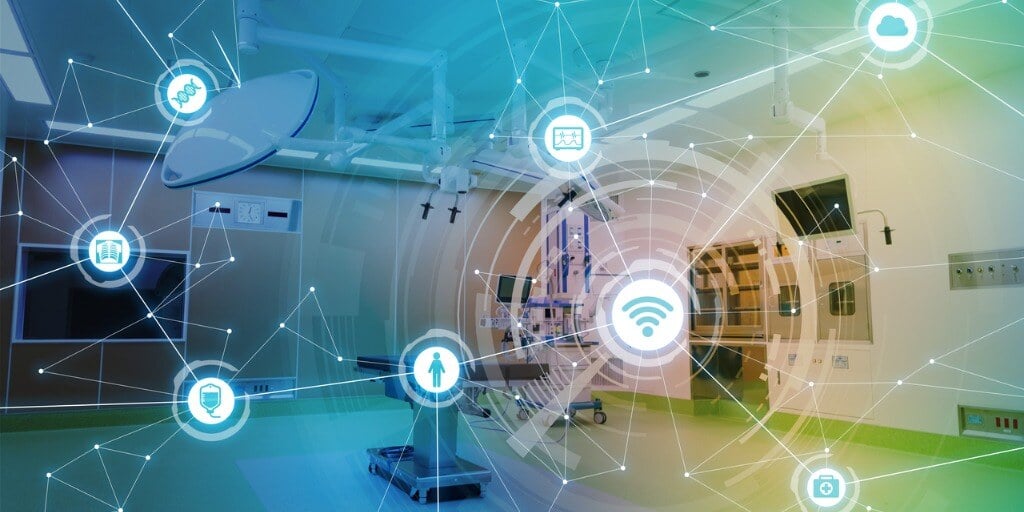The Internet of Medical Things (loMT) is a rapidly evolving technology reshaping the healthcare landscape. IoMT refers to the network of connected medical devices, wearables, and sensors that collect, transmit, and analyze patient data in real time. By leveraging this interconnected system, healthcare providers can deliver better, more personal care while improving operational efficiency.
In this post, we will explore:
- the history and development of IoMT,
- examples of IoMT application in hospitals,
- the Pros and Cons of IoMT and
- the impact on patient care and healthcare staff.
A Brief History of IoMT
The concept of connected medical devices traces its roots back to the broader Internet of Things (IoT) revolution, which began gaining momentum in the early 2000s. Early examples of IoMT included basic telemedicine systems and wearable health monitors like heart rate trackers. As wireless communication, data storage, and sensor technologies advanced, the IoMT ecosystem expanded to include more sophisticated devices.
By the mid-2010s, regulatory approvals for connected medical devices—such as insulin pumps and implantable cardiac monitors—opened new doors for innovation. Today, IoMT encompasses everything from wearable fitness trackers to surgical robots integrated with real-time data analytics.
Examples of IoMT in Action
IoMT encompasses a wide range of connected devices used across acute care and home settings. For this article we will focus on representative IoMT-related equipment used only in healthcare facilities.
- IoMT-Enabled Vital Signs Monitors collect and record real-time heart rate, blood pressure, body temperature and oxygen saturation.
- Smart Hospital Beds are equipped with sensors that monitor a patient’s vital signs and movement patterns.
- Connected Infusion Pumps ensure medication is administered in the correct dosage and at the proper intervals.
- Connected Anesthesia Machines monitor the patient and adjust anesthesia as needed during surgical procedures.
- MRI Machines and other large medical devices are integrated into IoMT systems for data sharing.
- Smart Operating Room Lights can be adjusted remotely to provide the optimal illumination for a specific procedure.
- Environmental Monitoring Devices track and adjust the temperature and humidity in healthcare facilities to maintain optimal conditions.
- RFID Asset Tracking Systems are employed to help staff locate medical equipment such as wheelchairs, IV poles, or infusion pumps within the facility.
- Patient Flow Management Systems track the movement of patients within a hospital or other care facility.
IoMT devices help improve patient care with real-time monitoring. With instant access to the most current patient information, healthcare staff can respond quickly to patient distress, adjust care routines, and have confidence all caregivers are making treatment decisions based on the same patient data.
Pros and Cons of IoMT
The Internet of Medical Things (IoMT) offers numerous advantages to healthcare facilities with the primarily focus being raising the standard of patient care, improving staff efficiency, and more accurate data management.
Pros of IoMT:
Higher Levels of Patient Care
IoMT devices offering 24/7 monitoring of patients' conditions allow healthcare providers to identify distress in the moment and intervene quickly or to adjust treatments promptly following the identification of readings contrary to the expected outcome.
Improved Operational Efficiency
IoMT technology can help streamline hospital operations in several ways:
Resource management: Hospitals can track medical equipment, staff, and patients in real-time, optimizing resource allocation and improving operational efficiency.
Cost reduction: With remote patient monitoring helping to reduce unnecessary hospital visits, IoMT helps control healthcare costs.
Data-Driven Decision Making
IoMT devices collect and transmit personal health data, which can positively affect:
Treatment plans: Healthcare providers can tailor treatments based on comprehensive, real-time patient data.
Improved diagnostics: Access to more accurate and timely data facilitates faster and more precise diagnoses.
Increased Accessibility to Specialized Care
IoMT fosters telemedicine and remote consultations, allowing patients to access specialized care without the need for travel. This is particularly beneficial for patients in rural or underserved areas.
Cons of IoMT:
The Internet of Medical Things (IoMT) unfortunately also presents several potential drawbacks, primarily around security, privacy, interoperability, and implementation challenges.
Security and Privacy Risks:
Vulnerabilities: IoMT devices, like any connected device, can have security vulnerabilities that can be maliciously exploited for unauthorized access to sensitive patient data, device hijacking, and disruption of medical services.
Data Breaches: The sheer volume of personal and sensitive health data collected and transmitted by IoMT devices make them prime targets for cyberattacks. The resulting data breaches can have severe consequences for patients and healthcare providers.
Malware and Ransomware Attacks: IoMT devices are susceptible to malware and ransomware attacks, which can disrupt operations, compromise patient data, and even hold medical equipment hostage.
Lack of Standardization: Inconsistent security standards and protocols across different IoMT devices and manufacturers makes it challenging to implement robust security measures and creates vulnerabilities.
Data Privacy Concerns: The collection, storage, and transmission of sensitive patient data raises significant privacy concerns related to unauthorized access, misuse, or sharing of this information.Interoperability and Integration Challenges:
Device Compatibility: IoMT devices from different manufacturers often lack interoperability, making it difficult to integrate them seamlessly into existing healthcare systems. Incompatibility can hinder data sharing within the healthcare continuum.
Data Standardization Issues: The lack of standardized data formats and protocols for IoMT devices can impede data exchange and analysis, making it challenging to use data effectively to improve patient care and outcomes.
Legacy System Integration: Integrating IoMT devices into existing legacy healthcare systems can be complex and costly, requiring significant investment in infrastructure upgrades and compatibility solutions.
Integration with EHRs: Seamlessly integrating IoMT data with Electronic Health Records (EHRs) is crucial for a holistic view of patient health, but it can be a complex process with potential for data silos and integration challenges.
Implementation and Management Challenges:
High Implementation Costs: Deploying and implementing IoMT solutions can be expensive, requiring investments in hardware, software, infrastructure, and training.
Complexity and Management Overhead: Managing a large network of connected medical devices can be complex and require specialized expertise in cybersecurity, data management, and device maintenance.
Technical Issues: Technical problems, such as device malfunction, network connectivity issues, and software glitches, can impact the reliability and functionality of IoMT devices, potentially affecting patient care.
Regulatory and Compliance Requirements: Meeting regulatory and compliance requirements for data security, privacy, and device safety can be complicated and challenging for healthcare providers implementing IoMT solutions.
Infrastructure and Scalability: The infrastructure needed to support a large-scale IoMT deployment can be significant, requiring robust network connectivity, data storage capacity, and scalability to meet growing demands.
Ethical and Societal Considerations:
Data Security and Privacy: The ethical implications of collecting and analyzing vast quantities of personal health data raises concerns about data security and privacy breaches.
Surveillance and Monitoring: The use of IoMT devices for continuous monitoring and surveillance raises ethical concerns about patient autonomy, privacy, and the potential for misuse of data for discriminatory purposes.
In conclusion, while IoMT offers significant inroads to improve healthcare, it is important to be aware of the drawbacks and address them proactively to ensure the safe, secure, and ethical implementation of these technologies.
The Impact of IoMT on Healthcare Staff
IoMT can positively impact healthcare staff by helping to streamline workflows and improve communication, ultimately leading to increased efficiency.
Here is a breakdown of how IoMT affects healthcare staff:
Improved Efficiency and Workflow:
Automation of tasks: IoMT devices can automate tasks such as monitoring vital signs, dispensing medication, and tracking patient movement, freeing up staff time for other essential duties.
Reduced administrative burden: By automating data collection and analysis, IoMT reduces the manual workload associated with record-keeping, data entry, and reporting, allowing staff to focus on patient care.
Faster access to information: IoMT enables real-time access to patient data, such as vital signs, medication records, and diagnostic results, facilitating faster and more informed decision-making.
Streamlined communication: IoMT devices and platforms facilitate seamless communication between healthcare professionals, patients, and caregivers, improving coordination and collaboration.
Refined Patient Care:
Remote patient monitoring: Following discharge from the hospital, IoMT enables remote monitoring of patients' health conditions, allowing for early detection of potential issues and timely interventions. Remote monitoring can help reduce the risk of readmission.
Personalized treatment plans: By collecting and analyzing data from IoMT devices, healthcare providers can curate treatment plans to individual patient needs.
Improved diagnostic accuracy: IoMT devices can provide detailed and continuous data, leading to more accurate diagnoses and better treatment decisions.
Increased Efficiency and Collaboration:
Data-driven decision-making: IoMT provides healthcare professionals with real-time data, facilitating more informed and data-based decision-making.
Improved interoperability: IoMT facilitates seamless data sharing across healthcare disciplines.
Reduced errors and improved safety: By automating tasks and providing real-time data, IoMT can help reduce medical errors and by extension, improve patient safety.
Increased access to specialized expertise: IoMT facilitates remote consultations with specialists, providing healthcare professionals with access to expert opinions and guidance, particularly in remote or underserved areas.
Conclusion
The Internet of Medical Things represents a new era of innovation in healthcare. Facilitating smarter, data-driven, decision-making, IoMT can be instrumental in helping improve patient outcomes, streamline healthcare delivery, and making healthcare more proactive. However, the challenges of data security and interoperability must be addressed to fully realize the potential of IoMT. As healthcare facilities put IoMT-enabled healthcare equipment into service, patients and providers alike stand to benefit from a more connected and efficient system.
The future of healthcare is here, and it’s digital.
![]() CHAT with CME about sourcing IoMT-enabled healthcare equipment.
CHAT with CME about sourcing IoMT-enabled healthcare equipment.
About CME: CME Corp is the nation’s premier source for healthcare equipment, turnkey logistics, and biomedical services, representing 2 million+ products from more than 2,000 manufacturers. With two corporate offices and 35+ service centers, our mission is to help healthcare facilities nationwide reduce the cost of the equipment they purchase, make their equipment specification, delivery, installation, and maintenance processes more efficient, and help them seamlessly launch, renovate and expand on schedule.



